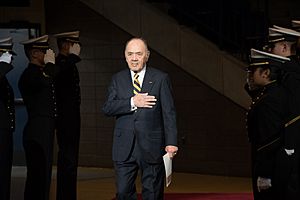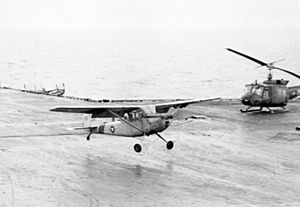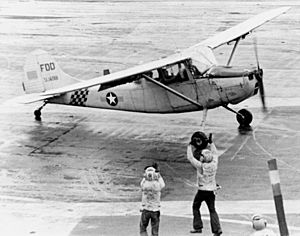Lawrence Chambers facts for kids
Quick facts for kids
Lawrence Cleveland Chambers
|
|
|---|---|

Chambers in 2018
|
|
| Nickname(s) | "Larry" |
| Born | June 10, 1929 Bedford, Virginia, U.S. |
| Allegiance | United States of America |
| Service/ |
United States Navy |
| Years of service | 1952–1984 |
| Rank | Rear admiral |
| Commands held | USS Midway (CV-41) USS Coral Sea (CV-43) Carrier Strike Group Three |
| Battles/wars | Vietnam War |
| Awards | Bronze Star Vietnam Service Medal Meritorious Service Medal |
| Website | https://www.midway.org/blog/admiral-lawrence-chambers-the-pathfinder |
Lawrence Cleveland "Larry" Chambers is a very important person in U.S. Navy history. He was born on June 10, 1929. He was the first African American to lead a huge aircraft carrier. He was also the first African American graduate from the U.S. Naval Academy to become a high-ranking admiral.
During a big rescue mission called Operation Frequent Wind, Admiral Chambers made a brave and difficult decision. He was in charge of the aircraft carrier USS Midway (CV-41). He ordered his crew to push many helicopters into the ocean. This made space for a South Vietnamese pilot, Major Buang-Ly, to land his small plane. Major Buang-Ly had his wife and five children with him. This quick thinking saved their lives.
Contents
Early Life and School
Growing Up in Virginia
Lawrence Chambers was born in Bedford, Virginia, in 1929. He was the third of five children. His mother, Charlotte Chambers, raised him and his siblings. His brother, Andrew Chambers, later became a high-ranking general in the U.S. Army. After their father passed away, their mother worked for the War Department. She worked hard to support her family.
Chambers went to Dunbar High School in Washington, D.C. He was part of the Junior ROTC program there. He was a top student and the leader of his cadet group. He thought about joining a college ROTC program to help pay for school.
However, Wesley A. Brown, the first African American to graduate from the U.S. Naval Academy, encouraged him. Chambers applied and was accepted. He became the second African American to graduate from the Naval Academy. This happened on June 6, 1952. Chambers had mixed feelings about his time there. He didn't visit the Academy again for twenty years. He later said he had both good and tough memories.
Becoming a Pilot
In 1954, Chambers finished 18 months of flight training. He officially became a Naval Aviator, a Navy pilot. His first job was flying planes that hunted submarines. He flew the Grumman AF Guardian. Later, he flew different types of attack jets. These included the A-1 Skyraider, A-4 Skyhawk, and A-7 Corsair II. He even helped start a new squadron, VA-67, and was its first leader.
Leading Ships and Fleets
From 1968 to 1971, Chambers flew combat missions. He flew over Vietnam from the aircraft carriers USS Ranger (CV-61) and USS Oriskany (CV-34). In 1972, he was promoted to captain. He then took command of the USS White Plains (AFS-4), a ship that supplied other Navy ships.
In January 1975, Captain Chambers made history. He became the first African American to command an aircraft carrier. This was the USS Midway (CV-41). He led the Midway until December 1976. After this, he was promoted to rear admiral. He then led Carrier Strike Group Three. He finished his Navy career helping to manage naval air systems.
Operation Frequent Wind
The Rescue Mission Begins
In April 1975, Admiral Chambers was in command of the USS Midway. He received orders to quickly sail to the waters off South Vietnam. North Vietnam was taking over the country. The mission was called Operation Frequent Wind. It was a huge effort to evacuate American and South Vietnamese people. At the time, the Midway was in Subic Bay Naval Base. Parts of its engines were being repaired.
Chambers said he didn't get a clear official order to start the operation. But on April 29, the Vice President of South Vietnam, Nguyễn Cao Kỳ, landed on the Midway. Chambers knew then that the rescue was underway. Soon, the carrier's flight deck was filled with helicopters. They were bringing refugees from the fall of South Vietnam.
A Brave Pilot's Landing
On that same day, a South Vietnamese air force pilot, Major Buang-Ly, took off. He had his wife and five children in a small, two-seat Cessna O-1 Bird Dog plane. He flew from Con Son Island. After avoiding enemy fire, Major Buang flew out to sea. He soon spotted the Midway.
The Midway crew tried to talk to his plane. But the pilot kept circling with his landing lights on. A crew member saw that there were at least four people in the small plane. This meant they couldn't ask him to ditch (land in the water) next to the ship. It was too risky for so many people in an overloaded plane.
After three tries, Major Buang dropped a note onto the deck. It said:
Can you move the helicopter to the other side, I can land on your runway, I can fly for one hour more, we have enough time to move. Please rescue me! Major Buang, wife and 5 child.
A Difficult Decision
Admiral Chambers talked with Admiral William L. Harris, the task force commander. Chambers then gave the order to let the small plane land on the Midway. The ship's landing wires were removed. All helicopters that couldn't be moved quickly were pushed overboard into the sea. This included about $10 million worth of UH-1 Huey helicopters.
The weather was not perfect for landing. There was a low cloud ceiling, light rain, and wind. Chambers ordered the ship to speed up to 25 knots into the wind. This helped create better landing conditions. Warnings about dangerous air currents behind the ship were sent out in Vietnamese and English. To make things harder, five more helicopters landed and crowded the deck. Chambers ordered them pushed overboard too.
Captain Chambers later remembered the landing:
the aircraft cleared the ramp and touched down on center line at the normal touchdown point. Had he been equipped with a tailhook he could have bagged a number 3 wire. He bounced once and came stop abeam of the island, amid a wildly cheering, arms-waving flight deck crew.
Major Buang was taken to the ship's bridge. Chambers congratulated him on his amazing flying and bravery. The Midway crew was so impressed. They started a fund to help Major Buang and his family settle in the United States. Major Buang's Bird Dog plane is now on display. You can see it at the National Naval Aviation Museum in Florida.
At the time, Chambers had only been in command of the USS Midway for a few weeks. He thought his order to push helicopters overboard might get him into trouble. But he called Major Buang-Ly the "Bravest man I have ever met in my life." He said about his decision: "When a man has the courage to put his family in a plane and make a daring escape like that, you have to have the heart to let him in."
Later Life
After retiring from the Navy, Chambers worked in program development. In 2010, he took part in events honoring Operation Frequent Wind.
On April 29, 2015, Chambers visited San Diego, California. He spoke aboard the USS Midway, which is now a museum ship. This was to remember the 40th anniversary of Operation Frequent Wind.
Chambers also helps young people. He works with Gordon Brown on the "Admiral Chambers and Gordon Brown Sr. Golf Invitational." This yearly event raises money for the "San Diego Inner City Junior Golf Foundation." This group helps city kids learn golf and important life skills. The money raised goes towards scholarships for students.
See also
- James H. Conyers, the first African American to attend the U.S. Naval Academy





